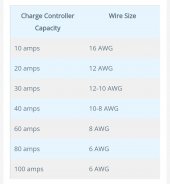BreezyReputation
New Member
- Joined
- Jul 15, 2022
- Messages
- 5
Hi everyone!
I’m brand new to the Solar scene. I want to start learning the basics now, and eventually work up to a system that will be able to support at least a portion of my home, or a camper.
I’ve just purchased some pretty basic hardware to set up a little lab and get familiar with terms, operation, setup, wants, and needs.
I picked up a Renogy 100w panel that came bundled with the Wanderer 10A charge controller. I already have a 410W inverter, and I’m going to pick up a 12v 10Ah Li battery probably today.
I’ve spent the morning refreshing on electrical basics, and shopping for fuses and cables.
It seems like 10A fuses aren’t very common, which doesn’t surprise me; with such a small current, most probably don’t even bother with a system that small.
So far, this is what I've come to:
panel > controller
20V, 5A = 21awg @ 3ft, 19awg @ 6ft, 17awg @ 9
5A x 25% safety factor = 6.25A maximum current, round up to 10A inline fuse.
controller > battery
12v, 10a (120w) = 16awg @ 3ft, 13awg @ 6ft, 12 @ 9ft
Fuse should match the controllers rating, 10A
battery > inverter
410w, 50a, 12v = 8awg @ 3ft, 7awg @ 6ft, 5awg @ 9ft
410w / 12v / .85 x 1.25 = 50.24A
inverter rating / battery voltage / efficiency rating x 25% safety factor
I appreciate any feedback on what I've got planned. Also, any reference to cable sizes would be appreciated...there's a lot more to consider when it comes to choosing the right cable. I'm trying to do everything exactly to spec on this small scale, and then slowly scale up as I become more comfortable with the system.
Thanks!
I’m brand new to the Solar scene. I want to start learning the basics now, and eventually work up to a system that will be able to support at least a portion of my home, or a camper.
I’ve just purchased some pretty basic hardware to set up a little lab and get familiar with terms, operation, setup, wants, and needs.
I picked up a Renogy 100w panel that came bundled with the Wanderer 10A charge controller. I already have a 410W inverter, and I’m going to pick up a 12v 10Ah Li battery probably today.
I’ve spent the morning refreshing on electrical basics, and shopping for fuses and cables.
It seems like 10A fuses aren’t very common, which doesn’t surprise me; with such a small current, most probably don’t even bother with a system that small.
So far, this is what I've come to:
panel > controller
20V, 5A = 21awg @ 3ft, 19awg @ 6ft, 17awg @ 9
5A x 25% safety factor = 6.25A maximum current, round up to 10A inline fuse.
controller > battery
12v, 10a (120w) = 16awg @ 3ft, 13awg @ 6ft, 12 @ 9ft
Fuse should match the controllers rating, 10A
battery > inverter
410w, 50a, 12v = 8awg @ 3ft, 7awg @ 6ft, 5awg @ 9ft
410w / 12v / .85 x 1.25 = 50.24A
inverter rating / battery voltage / efficiency rating x 25% safety factor
I appreciate any feedback on what I've got planned. Also, any reference to cable sizes would be appreciated...there's a lot more to consider when it comes to choosing the right cable. I'm trying to do everything exactly to spec on this small scale, and then slowly scale up as I become more comfortable with the system.
Thanks!






